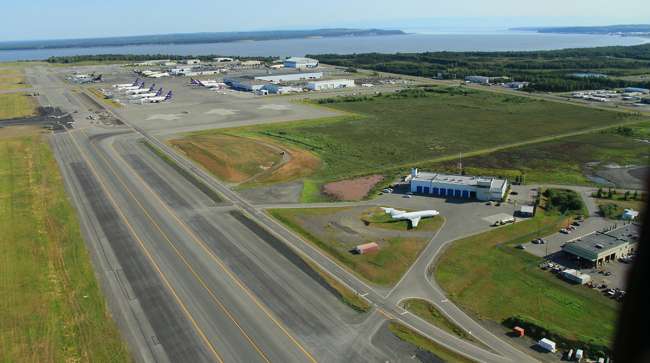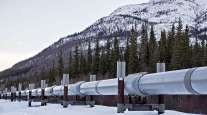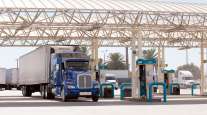Anchorage’s International Airport Adds 5 Carriers

[Stay on top of transportation news: Get TTNews in your inbox.]
The Ted Stevens Anchorage International Airport has added five new international cargo carriers to its lineup this year, setting the stage for continued growth at an aviation crossroads that’s already among the world’s busiest for shipping, state officials said Oct. 24.
The additions come as companies pursue new or expanded developments at the Anchorage facility that could support even more of the jumbo cargo jets, including ongoing construction of the $200 million NorthLink Aviation cargo terminal near Kincaid Park.
Also, Alaska Cargo and Cold Storage plans to soon begin construction of a large cargo transfer and cold-storage facility west of the airport post office, state officials said. And FedEx, which employs nearly 1,400 people in Alaska, is investing $200 million to enhance its sorting facility in Anchorage, according to its 2024 economic impact report.
“The new facility will process 6,000 packages per hour, boosting local shipping capacity and supporting the flow of goods across the state,” the company said in a statement Oct. 24.
Ted Stevens Anchorage International Airport announces the arrival of five new cargo carriers, reinforcing its status as a global air cargo hub.
Details in press release: https://t.co/RbIuHQkrh6 pic.twitter.com/O1o7xusrqe — Alaska DOT&PF (@AlaskaDOTPF) October 24, 2024
FedEx ranks No. 2 on the Transport Topics Top 100 list of the largest for-hire carriers in North America.
Anchorage’s airport has been an economic bright spot in Alaska for years, and that status is poised to grow, helping create more jobs, said Gov. Mike Dunleavy, announcing the new cargo companies at a press event Oct. 24 at the airport’s police and fire headquarters.
“This is part of the whole concept of creating an Alaska for the next 50 years for our kids and our grandkids,” Dunleavy said.
Cargo use at the Anchorage airport soared during the pandemic, bumping it to the world’s third-busiest cargo hub in 2022, from sixth place. After changes in global shipping led to some jostling in the rankings, Anchorage now holds fourth place, trailing Hong Kong, Memphis and, by a small margin, Shanghai.
Strategically perched midway between Hong Kong and the Lower 48, the airport benefited as homebound consumers in the U.S. bought more computers, cellphones, pharmaceuticals and other products, airport officials have said.
McLeod Software CEO Tom McLeod explores the potential for artificial intelligence to boost efficiency and build resilience. Tune in above or by going to RoadSigns.ttnews.com.
With a stop in Anchorage, carriers can fuel up and change crews. The stop allows them to haul less fuel and carry more of the valuable cargo on their intercontinental journey.
Problems in the maritime shipping industry, including higher costs and snarled supply chains, have also energized cargo business at the airport.
The five new cargo carriers at the airport increase its international roster to 31 cargo carriers, airport officials said. Eight regional cargo carriers also use the airport.
The new international companies are expected to boost annual revenues at the airport by an expected $9 million, or 7%, with revenues from landing fees and other charges, they said.
The airport saw a 4.9% year-over-year increase in cargo activity last fiscal year, and anticipates 2% growth in the current fiscal year, the airport said in a statement Oct. 24. The growth should lead to a record amount of landed weight at the airport.
The new companies with stops in Anchorage are:
- Awesome Cargo Airlines, of Mexico, flying from Incheon in South Korea to Mexico City
- Central Airlines of China, linking Shenzhen in China with Ontario, Calif.
- Belgian company ASL Air Cargo, flying several times monthly between Jinan, China, and John F. Kennedy International Airport in New York
- AeroLogic Air Cargo of Germany, flying from Hong Kong and Guangzhou in China to Cincinnati/Northern Kentucky International Airport
- French company, CMA CGM Air Cargo, flying from Hong Kong to Dallas/Fort Worth and Chicago
State transportation officials speaking at the event said they are also pursuing projects to reduce the airport’s impact on the environment, including the possibility of adding solar panel arrays, and the installation of a cogeneration power facility in the North Terminal to use natural gas more efficiently.
They said the airport will soon begin to transition away from PFAS, the toxins known as “forever chemicals” that have been used by airports in some firefighting foams and caused contamination at some sites at the Anchorage airport.
“We’re in the process of procuring the chlorine-free foams so that we can replace the foams that are in our equipment,” said Ryan Anderson, commissioner of the Alaska Department of Transportation and Public Facilities. “And then there’s a process to cleaning the equipment to make sure that it’s ready to use in the appropriate ways. So we expect that this winter, we will have this equipment cleaned and we’ll be fully functional with the new foams.”
Want more news? Listen to today's daily briefing below or go here for more info:
Distributed by Tribune Content Agency, LLC





